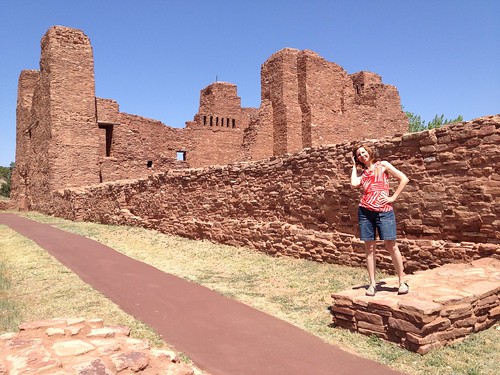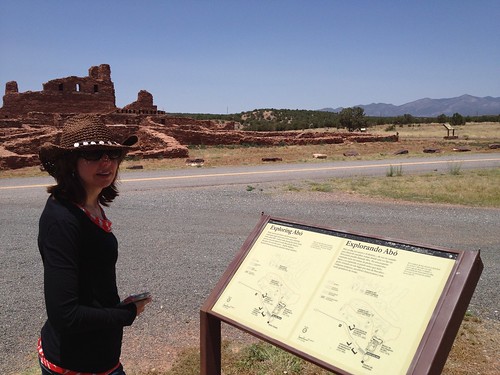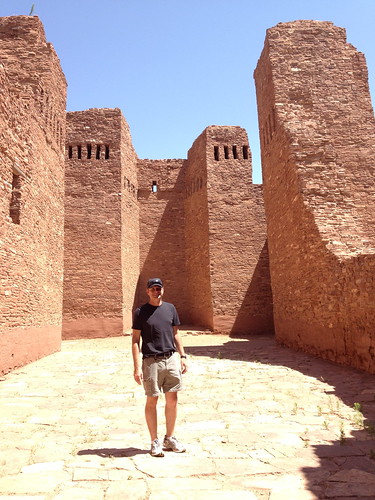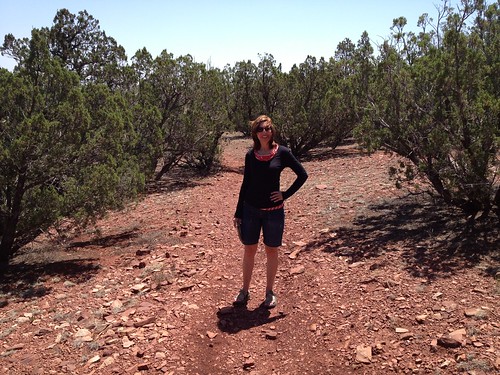I have a lot of catching up to do on this blog. I never finished writing about our experiences in Albuquerque, and I never even STARTED writing about events since we returned to Michigan or the Fourth of July festivities or my trip to Washington, D.C., and now we’re heading to Canada tomorrow for a few days, which will generate even MORE blog-worthy news. Time to get crackin’.
So … back to Albuquerque.
Walking through the red sandstone ruins of the Salinas Pueblo Missions on June 22, I kept picturing the Native Americans of the Salinas Valley and the anxiety they must have felt at the arrival of Spanish missionaries more than 300 years ago. Here’s some background, from a National Park Service brochure:
Before they left the area in the 1670s, Pueblo Indians forged a stable agricultural society whose members lived in apartment-like complexes and participated, through rule and ritual, in the cycles of nature. … The Salinas Valley became a major trade center and one of the most populous parts of the Pueblo world, with perhaps 10,000 or more inhabitants in the 1600s. Located along major trade routes, the villagers were both producers and middlemen between the Rio Grande villages and the plains tribes to the east. They traded maize, piñon nuts, beans, squash, salt, and cotton goods for dried buffalo meat, hides, flints and shells. … In the 1670s the Salinas villages were abandoned and their people dispersed.
Although Spanish explorers (traveling from Mexico) failed to discover the mythical riches of the north, Spain accepted its charge from the Pope to Christianize the natives of the New World.
Tony and I explored two of the three Salinas Pueblo Missions, southeast of ABQ. At the suggestion of Sarah, innkeeper at the Adobe Nido B&B, we took the scenic route through the mountains. Totally worth it! We stopped first at Quarai, which was a thriving pueblo when Juan de Oñate arrived in 1598 to demand allegiance to Spain. We walked the shady path that passed by unexcavated mounds, ultimately arriving at the red-walled church ruins. After checking out the site, we enjoyed a peaceful trek through the surrounding piñon trees.

From there, we drove to Abó, where Franciscans started converting residents in 1622. Two churches were built here, including one with an unusually sophisticated buttressing system.

That circle in front of the church ruins was an underground kiva, a sacred chamber for special ceremonies. The kiva reflects the co-existence of Pueblo religious rituals and Christian traditions at the missions. That co-existence was doomed, obviously. Pueblo priests began to doubt the Christian god was powerful enough to meet their communal needs (summer rain and bountiful harvests), and Franciscans destroyed Kachina masks and kivas to discourage native religions.
For tons more information (567 pages, to be exact!) about the history and culture of the Salinas Pueblo Missions, check out “In the Midst of a Loneliness,” a PDF on the National Park Service website.
A third site, Gran Quivira, is located about 25 miles off the main road. As we were getting a bit peckish, we decided to skip it and head back to the city for lunch.
Returning to Albuquerque, we crested a hill and emerged in the plains. This was our view for most of the trip.

Oh, another great resource is the book, Salinas Pueblo Missions – Abó, Quarai & Gran Quivira by Dan Murphy. I just realized I lifted this book from the B&B by accident, so I’ll go pop it in the mail!



